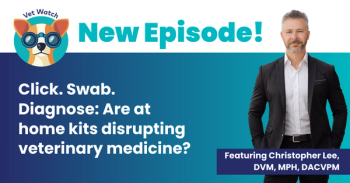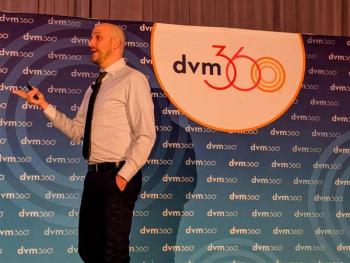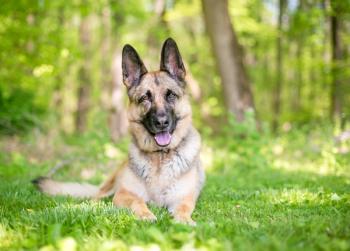
GI and urinary system contrast radiography: Not a dying art (Proceedings)
Administer the contrast medium any place in the hospital except with the patient on the x-ray table.
Agents Used Most Frequently
Contrast media and Use
Barium Sulfate
• Digestive system
Ionic contrast medium
• Vascular
Diatrizoate
• Digestive
Sodium &/or Meglumine
• Urogental
• Intracavitary
• Articular
• Fistula
Non-Ionic contrast medium
• Vascular
Ioxilan
• Urogental
• Fistula
Iohexol
• Central nervous system
• Vascular
• Digestive
• Urogenital
• Intracavitary
• Articular
• Fistula
Gas: Carbon Dioxide
• Digestive
Urogenital
• Intra-cavitary
• Articular
Room air
• Digestive
• Urogenital
• Intra-cavitary
• Articular
Studies to be Discussed
• Digestive System
• Urogenital System
• Intra-Cavitary
Digestive System:
What I have learned from doing digestive system contrast studies:
• Be positive about the procedure even if you use negative contrast medium.
• Prepare the patient and the owner.
• You can not determine esophageal motility status if the pet is sedated or anesthetized.
• You may not be able to determine gastric or bowel motility status if the pet is sedated or anesthetized.
• Administer the contrast medium any place in the hospital except with the patient on the x-ray table.
• If you get barium on your clothing-especially the shoes-wash it off immediately as it is much harder to remove later on.
• A barium/contrast study is either normal or abnormal.
• If it is normal-be happy for the patient-however, it does not mean the GI system is normal.
• If it is abnormal-decide if it is related to a non-obstructive or an obstructive disease process:
Non obstructive:
• Altered bowel dynamics
• Bowel not pathologically distended.
• Bowel wall thickened
• Bowel mucosa irregular
• Barium flocculates
Obstructive:
• Pathological distention of the bowel
• Contrast may not traverse the bowel
Twenty-five percent of the time your exploratory will not reveal a definitive lesion-then biopsy the bowel!
A negative contrast gastrogram is a good way to define gastric pliability, wall thickness/contour and gastric luminal content.
A barium enema is a good way to distinguish between large and small bowel.
Endoscopy, ultrasound and exploratory surgery are often required to make a definitive diagnosis.
Esophogram:
• No sedation or anesthesia
• Obtain survey lateral and VD or VD oblique radiographic projections.
• Place contrast in oral cavity and allow animal to swallow it
• Contrast-
o General evaluation-
• Barium sulfate-1 ml/lb.
o If you suspect esophageal perforation use water soluble medium
• Any water soluble iodinated contrast medium should be good- 1 ml/lb.
• Repeat the radiographic projections immediately
Negeative Contrst Gastrogram:
• Sedation recommended:
Acepromazine IV in Dogs
Ketamine/Valium IV or SQ in cats
• Obtain survey lateral and VD radiographic projections
• Pass the orogastric tube
• Inflate the stomach with room air—6 ml/lb
• Remove the tube and repeat the radiographic projections.
Positive Contrast Gastrointestinal Series
• If sedation needed use acepromazine IV in dogs and ketamine/valium in cats
• Obtain survey lateral and VD radiographic projections.
• Place contrast in the esophagus or into the stomach with an orograstric tube
• Contrast
o General evaluation-use barium sulfate-4ml/lb
o If suspect GI perforation use water soluble iodinated contrast medium-2 ml/lb
• Radiographic projections repeated after contrast administration at the following times:
o Canine: 10 minutes post contrast administration
• 1 hour post contrast administration
• 2 hours post contrast administration
• 4 hours post contrast administration
o Feline: Immediately after contrast administration
• 15 minutes after contrast administration
• 30 minutes after contrast administration
• 45 minutes after contrast administration
• General comments:
A GI series is not completed until a lesion is defined or the majority of the contrast has traversed the bowel. In the canine, radiographs may need to be taken eight hours post-contrast administration or the next day and in the cat, radiographs may need to be taken two hours post-contrast administration to complete the study.
Urogenital
Intravenous urogram
• Make sure colon and urinary bladder are empty
• Obtain survey lateral and VD radiographs
• Place a catheter in the cephalic vein
• Place a catheter in the urinary bladder
• Inject water soluble contrast medium intravenously-1ml/lb
• Obtain radiographs within one to two minutes after injection (lateral, VD and oblique projections as needed)
• Distended the urinary bladder with gas-4ml/lb
• Obtain radiographs five minutes after the bladder is distended (lateral, VD and oblique projections as needed)
• Obtain radiographs ten-fifteen minutes after bladder is distended.
Negative contrast cystogram
• Make sure the colon is empty
• Obtain survey lateral and VD oblique radiographs
• Place catheter in the urinary bladder
• Distend the bladder with gas-4 ml/lb.
• Obtain lateral and VD oblique radiographs
Positive contrast cystogram
• Make sure the colon is empty
• Obtain survey lateral and VD oblique radiographs
• Place catheter in the urinary bladder
• Distend the bladder with water soluble iodinated contrast medium –2 ml/lb.
• Obtain lateral and VD oblique radiographs
Double contrast cystogram
• Make sure the colon is empty
• Obtain survey lateral and VD oblique radiographs
• Place catheter in the urinary bladder
• Place a small amount of water soluble iodinated contrast medium into the bladder 1 ml for cat, 2 ml for small dog, 3 ml for medium size dog, 4 ml for large size dog or 5 ml for giant size dog (note this is total volume, not per pound)
• Distend the urinary bladder with gas-4 ml/lb
• Obtain lateral and VD oblique radiographs
Positive contrast urethrogram
• Make sure the colon is empty
• Obtain survey lateral and VD oblique radiographs
• Fill the catheter with positive contrast medium
• Place the catheter into terminal portion of urethra
• Secure the catheter in place
• Inject positive contrast medium 5 ml for small dog or cat
• 10 ml for medium size dog; 15 ml for large or giant size dog
• Obtain lateral radiograph while completing injection
• Repeat the injection
• Take VD oblique radiograph while completing the injection
Positive contrast vaginogram
• Make sure the colon is empty
• Obtain survey lateral and VD oblique radiographs
• Fill the catheter with positive contrast medium
• Place the catheter into terminal portion of the vagina
• Secure the catheter in place
• Inject positive contrast medium 5 ml for small dog or cat
o 10 ml for medium size dog; 15 ml for large or giant size dog
• Obtain lateral radiograph while completing injection
• Obtain VD oblique radiograph.
Positive Contrast Peritoneogram
• Obtain survey lateral and VD radiographs
• Sedate the animal
• Place a catheter into the abdominal cavity-catheter should be inserted adjacent to the umbilicus and just to the right of the midline.
• Inject sterile water soluble contrast medium into the peritoneal cavity-1 ml/lb
• Remove the catheter
•Massage the abdomen to distribute the contrast medium.
• Obtain lateral and VD or DV radiographs.
• General comments:
o If free fluid is present in the abdomen, remove as much of the fluid as you can before injecting the positive contrast medium
o If you suspect a hernia, position the animal for three minutes so that the positive contrast medium will flow towards the suspected hernia site.
o The positive contrast medium will be absorbed and you will eventually see it in the kidneys and urinary bladder.
Newsletter
From exam room tips to practice management insights, get trusted veterinary news delivered straight to your inbox—subscribe to dvm360.




